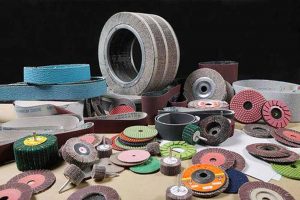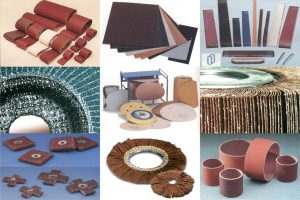Home / News & Blog / Abrasive Blog / The Ultimate Guide to Abrasive for Coated Abrasives
Coated abrasives are a go-to tool in industries like automotive, metalworking, woodworking, and construction, offering precision and efficiency for a wide range of tasks. These abrasives, which are typically sandpaper, sanding belts, and discs, consist of abrasive grains adhered to a backing material with a resin or adhesive. Picking the right abrasive for your coated abrasives is essential to getting top-notch results and making sure your tools perform at their best.
In this guide, we’ll dive into the different types of abrasives used for coated abrasives, what to consider when picking the right one, and how they’re used in various industries.


Coated abrasives are materials where abrasive grains are attached to a backing material—like paper, cloth, or film—using a resin or adhesive. These abrasives are used for all kinds of grinding, polishing, sanding, and finishing jobs. Common examples of coated abrasives include sandpaper, sanding belts, and abrasive discs.
Key Features of Coated Abrasives:
Flexibility: The backing material allows the abrasive to bend and conform to the surface you’re working on.
Durability: These abrasives are designed to handle high pressure, heat, and friction during use.
Efficiency: Coated abrasives remove material from surfaces quickly, helping achieve smooth finishes or preparing materials for further processes.
When choosing the right abrasive for coated abrasives, it’s important to understand the different types and how they perform. Here are the most common abrasives used in these products:
Aluminum Oxide (Al₂O₃)
Aluminum oxide is one of the most commonly used abrasives for coated abrasives. It comes in two main forms: brown fused alumina and white fused alumina. Aluminum oxide abrasives are great for general-purpose grinding and sanding.
Brown Fused Alumina (BFA): Known for its toughness, it’s often used in applications like metalworking, woodworking, and general sanding.
White Fused Alumina (WFA): Offers a finer, more precise finish, typically used for polishing and high-precision sanding.
Silicon Carbide (SiC)
Silicon carbide is another popular abrasive, known for its sharpness, hardness, and brittleness. It’s great for use on hard materials like ceramics, glass, and some metals. It’s especially useful in coated abrasives where high cutting power is needed.
Green Silicon Carbide: Best for a finer finish, typically used for polishing metals and glass.
Black Silicon Carbide: Often used for heavy-duty applications like metal grinding and sandblasting.
Zirconia Alumina
Zirconia alumina is a high-performance abrasive that’s made by combining aluminum oxide and zirconium oxide. It’s especially useful for heavy-duty grinding tasks, such as grinding steel and stainless steel, as well as alloys.
Advantages: Zirconia alumina is known for its high resistance to wear and heat, making it perfect for aggressive grinding applications. It lasts longer than brown fused alumina, which is great for businesses that need to maximize their tool’s lifespan.
Ceramic Alumina
Ceramic alumina is a high-performance abrasive known for its superior hardness and durability. It’s designed for tough, heavy-duty grinding applications, and is often used in industries like automotive and aerospace.
Advantages: It’s self-sharpening, meaning it maintains its cutting ability over time, and it’s excellent at withstanding heat and pressure.
Garnet
Garnet is a naturally occurring abrasive that’s much milder than other abrasives. It’s often used in applications where a gentler abrasive is required, like polishing or surface preparation.
Advantages: It’s perfect for softer materials and offers a finer finish without being overly aggressive.
Other Specialized Abrasives
Aluminum Silicate: This abrasive is used for polishing, as it provides a fine finish on softer materials.
Diamond Abrasives: Although not commonly used in coated abrasives, diamond abrasives are sometimes incorporated when precision finishing is required, especially for hard materials like ceramics or composites.
Selecting the right abrasive isn’t just about picking any grain; several factors need to be considered to make sure it suits your specific needs.
Material Type
The material you’re working with plays a huge role in determining which abrasive will work best. Softer materials like wood might require a more flexible, less aggressive abrasive, while harder materials like metals or ceramics need abrasives with greater hardness and durability.
Desired Finish
If you’re looking for a fine finish, you’ll want to use abrasives with finer grains, like white fused alumina or green silicon carbide. For more aggressive material removal, you’ll need abrasives like brown fused alumina or zirconia alumina.
Durability and Longevity
Think about how long you need the abrasive to last. Abrasives like ceramic alumina or zirconia alumina are great for heavy-duty grinding, as they last much longer than standard abrasives. If you’re looking for an abrasive that can handle tough tasks without needing to be replaced too often, go with one that offers more durability.
Cost-Effectiveness
Cost matters, especially if you’re purchasing abrasives in bulk. While ceramic alumina offers superior performance, it comes at a higher price. If you’re looking for something affordable yet effective for everyday grinding, brown fused alumina or silicon carbide are excellent options.
Speed and Efficiency
If you’re working in an environment where speed is crucial, you’ll need an abrasive that allows for high cutting efficiency. Zirconia alumina and ceramic alumina are perfect for fast-paced environments, while garnet abrasives tend to be slower but deliver a finer finish.
Coated abrasives are used across many industries, depending on the job at hand. Here’s where they’re typically used:
Metalworking
Industries like automotive, aerospace, and general manufacturing rely heavily on coated abrasives for grinding, polishing, and finishing metals. Aluminum oxide, zirconia alumina, and silicon carbide are commonly used for metalworking tasks, especially for tougher metals.
Woodworking
Coated abrasives are essential for woodworking, particularly in sanding tasks. Aluminum oxide and garnet abrasives are commonly used for sanding wood, furniture, and cabinetry to achieve smooth finishes.
Automotive and Aerospace
Heavy-duty grinding and finishing tasks in the automotive and aerospace industries often use ceramic alumina and zirconia alumina abrasives, ideal for grinding high-strength metals and alloys.
Glass and Ceramics
Silicon carbide is perfect for grinding and polishing glass and ceramics. Its sharpness and ability to withstand high temperatures make it an excellent choice for these fragile yet tough materials.
Choosing the right abrasive for your coated abrasives is critical to achieving the best results. By considering the material you’re working with, the finish you need, the durability, and the cost, you can make an informed decision and choose an abrasive that will suit your needs perfectly.
Understanding the different types of abrasives—whether aluminum oxide, silicon carbide, zirconia alumina, or others—will help you choose the right material for your grinding and finishing processes. Whether you’re producing grinding wheels, sanding belts, or polishing pads, selecting the right abrasive is key to achieving top-notch results.
◆☞ Abrasives for coated abrasives available from DOMILL:
Brown Fused Alumina
A22: The abrasive is sharp, has a low build-up density, and is self-sharpening. The coated abrasives made from them are sharp, have good heat dissipation, and have high grinding efficiency, making them suitable for producing standard coated abrasives. They are ideal for hand sanding various metals and wood.
A25: The abrasive is polygonal with moderate packing density. The coated abrasives have good sharpness, durability, and high grinding efficiency, and are used for making abrasive cloth, abrasive paper, abrasive belts, and processing mild steel, alloy steel, and hardwood.
Medium-temperature calcined brown fused alumina
AT22: The abrasive is sharp, with low packing density and self-sharpening. Its toughness, hydrophilicity, cleanliness, magnetic content, and hardness are significantly improved compared with A22. The coated abrasives made of it are sharp, with good heat dissipation and high grinding efficiency, and the abrasive cloth and sandpaper made of it are suitable for hand sanding of various metals and wood.
AT25: The abrasive is polygonal with moderate packing density. Its toughness, hydrophilicity, cleanliness, magnetic content, and hardness are significantly improved compared with A25. The abrasives made of it have high sharpness, good heat dissipation, improved durability, and high grinding efficiency, and the mid-range coated abrasives made of it are suitable for processing low carbon steel, alloy steel, hard bronze and hard wood.
High-temperature calcined brown fused alumina
AB22: The abrasive is pointed, irregular, sharp particles, with low bulk density, after calcination treatment, its toughness, hydrophilicity, cleanliness, magnetic content, and hardness than AT22 significantly improved. The abrasives made of it have high sharpness, good heat dissipation, and improved durability; it is used for high-grade coated abrasives, making abrasive cloth, sandpaper, abrasive belts, processing of low carbon steel, alloy steel, and special wood.
AB25: The abrasive is polygonal, with moderate stacking density. Its toughness, hydrophilicity, cleanliness, magnetic content, and hardness are significantly improved compared with AT25; the abrasives made of it have high sharpness, good heat dissipation, and improved durability; it is used for high-grade coated abrasives, making abrasive cloths, sandpaper, abrasive belts, processing of low carbon steel, alloy steel, and special wood.
Coated brown fused alumina
ATR25: Medium-temperature coated, bright red in color, with polyhedral-shaped particles and moderate bulk density. Compared to AT25, ATR25 shows significantly improved hydrophilicity, giving it strong adhesion, good sharpness, and excellent heat dissipation. It is primarily used in the production of high-end sandpaper, sanding cloths, and sanding belts for coated abrasives, suitable for polishing high-quality panels and processing low-carbon steel, alloy steel, and more. It ensures good grinding efficiency while maintaining durability.
ABR25: High-temperature coated, dark red in color, with polyhedral-shaped particles and moderate bulk density. Compared to ATR25, the toughness, hydrophilicity, cleanliness, magnetic content, and hardness of this product are significantly improved after high-temperature coating. It features strong adhesion and excellent heat dissipation. It is mainly used for the production of high-end coated abrasives and high-value non-woven abrasives, suitable for polishing high-quality hardwood panels and heavy-duty sanding of metals with abrasive belts.
White fused alumina
WA22: With a sharp shape and low bulk density, the coated abrasives made from it are sharp, have low toughness, and offer high grinding efficiency, making them suitable for the production of sandpaper, nylon wheels, and sponge sanding pads.
WA25: With a polyhedral shape, relatively regular particles, and sharp edges, it has a moderate bulk density. Coated abrasives made from it offer good hardness, moderate toughness, and high grinding efficiency. Sandpaper, nylon wheels, and sponge sanding pads made from it are more wear-resistant than those made with WA22.
Monocrystalline Fused Alumina
MA22:It has a blue, sharp shape with low bulk density and high sharpness, mainly used for producing high-end coated abrasives, high-demand hardwood polishing, and heavy-duty metal abrasive belt grinding. It is suitable for hard and tough-to-grind metal materials such as stainless steel, high-vanadium high-speed steel, heat-resistant alloy steel, and workpieces prone to deformation and burning.
As a professional supplier of abrasives with 30 years of industry experience and technology accumulation, DOMILL provides integrated services from R&D, and production to sales to ensure that customers can obtain the most suitable products for their needs. In addition, DOMILL also has strong R&D capabilities and the ability to guarantee stable delivery of large quantities, which can meet the diversified needs of customers. By choosing DOMILL as your abrasive supplier, you will gain a reliable, professional and innovative partner for your success in industrial manufacturing.